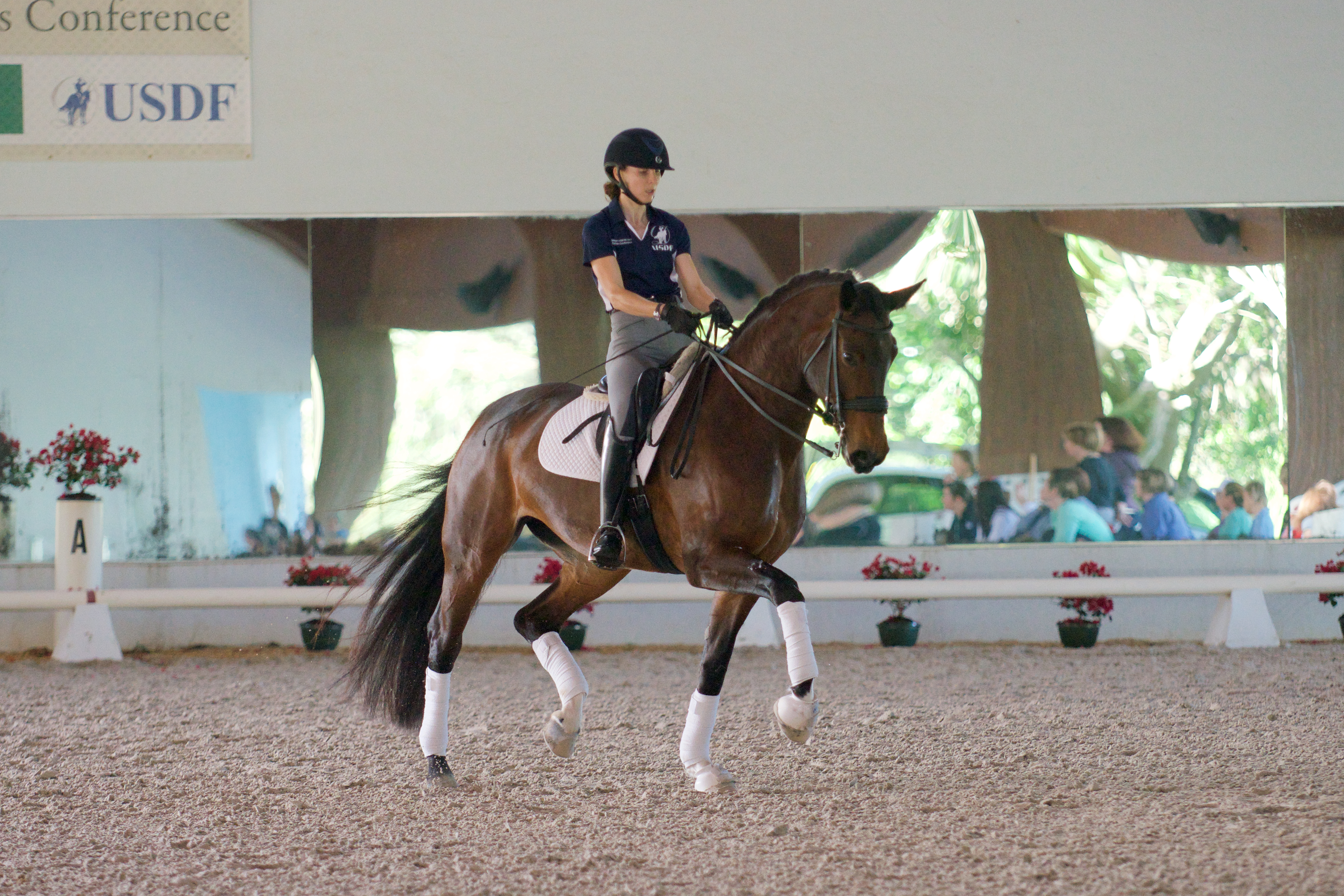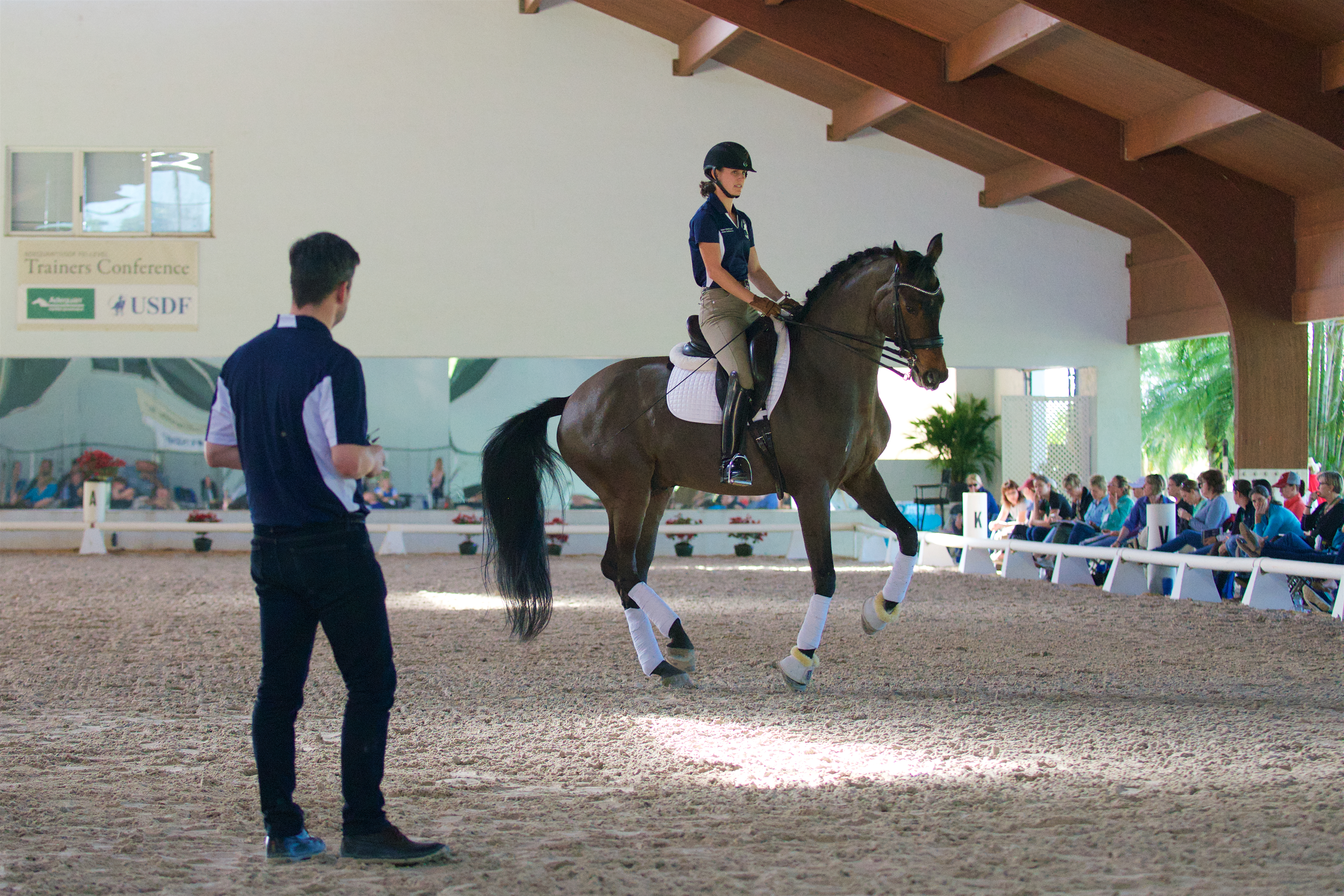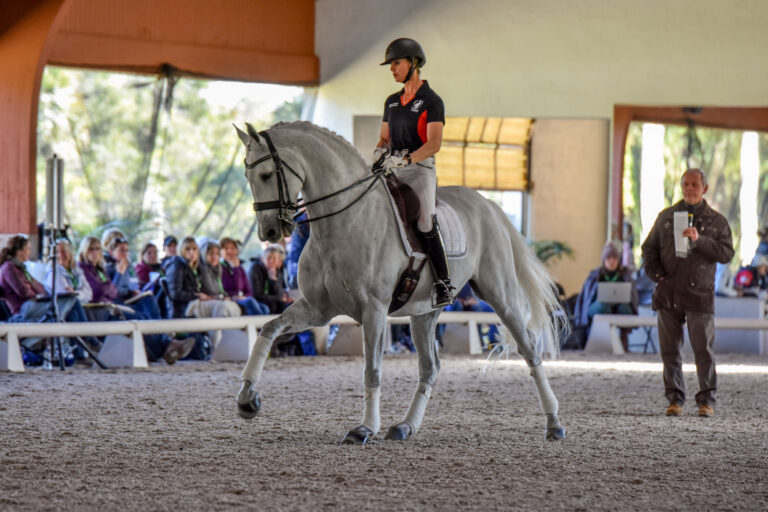The annual Adequan®/USDF FEI-Level Trainers Conference was, for the first time, combined with the USEF Judges Forum this Jan. 16–17. Sponsored by Adequan and Gardy Bloemers, Wealth Management Advisor of Merrill Lynch, and graciously hosted by Mary Anne McPhail at her High Meadow Farm in Loxahatchee, Florida, the event was perhaps the most highly attended Trainers Conference yet.
By combining trainers and judges, it was hoped that the situations presented by demonstration horses and riders might bring about enlightening discussions among the experts. On Day One, the conference, although enlightening, followed its standard format, so it didn’t fulfill the original vision of a combined conference for judges and trainers. Day Two was a different story, as trainers and judges shared ideas to help riders improve their performances for better scores. On the second day, Lilo Fore partnered with the trainers and Hans-Christian Matthiesen partnered with the judges, and they took turns welcoming comments from each very knowledgeable group. Of course, Lilo and Hans-Christian weighed in with their own sound opinions, too.
Conference Leaders

Lilo Fore (USA) is a judge of many titles: retired FEI 5*, Para 3*, USEF “S” and Dressage Sport Horse judge “R.” She was one of the founders of the USDF Instructor/Trainer Certification program and she is its current chair. She is also a member of the USEF Dressage Committee.
Hans-Christian Matthiesen (DEN), in addition to being a veterinarian, is an FEI 5* judge, a member of the FEI Dressage Committee, a member of the board of directors of the Danish Equestrian Federation, chair of the Danish Selection Committee and the president of the International Dressage Officials Club.

Trainers who have been to this event year after year felt that the quality of demonstration horses and riders was quite high this year. Nora Batchelder of River House Hanoverians in Williston, Florida, kicked off each day, riding her own Fifi MLW, a 7-year-old Third Level Hanoverian mare by Fidertanz. This horse-and-rider combination was a model of relaxed yet powerful, cadenced confidence. It was hard to find fault with them, and the experts agreed that Fifi would get an 8 for gaits on a bad day.
It’s the nature of judges and trainers to look for the strengths of horses and riders, but no one had to look far in this case. They discussed and admired the freedom of both the hindquarters and the forehand, the jumping quality of the canter and the ease of Fifi’s naturally motivated way of going. “It is as if she always has someplace to go,” said Lilo, “and yet they keep a lovely connection and balance.”
They noted that Fifi’s right and left canters were similar, but she perhaps had more ability to collect on the right. Hans-Christian challenged the pair by suggesting that they not stay in the same tempo too long. So they went forward and came back with ease and fluidity, the strides getting bigger and loftier, rather than faster, and then collecting smoothly to demonstrate enviable adjustability. Lilo commented that collection has nothing to do with slowing down, and Nora demonstrated how to gain collection with the inside leg and the outside rein without giving up the tempo or the bend.
On Day Two, each rider was asked to do a test movement from an appropriate level, so Nora and Fifi were asked to do the Third Level shoulder-in, circle and half pass. Observers studied—and admired—the carriage, straightness, suppleness, height of the poll and equality of circles left and right. Members of the judges’ group gave marks followed by members of the trainers’ group. This horse was highly rewarded for her extraordinary cadence and expression coupled with perfect relaxation. Fifi and Nora provided an inspiring start each day.

Elizabeth Caron from her family farm, Carbery Fields, in Lebanon, Connecticut, presented another lovely picture, riding Schroeder, the 12-year-old Hanoverian Sandro Hit stallion owned by Kathy Hickerson.
Schroeder and Liz have competed at Grand Prix, and Hans-Christian reminded the audience of the huge repertoire of a horse as educated as Schroeder. The immediate goal was to help him relax in the tense atmosphere. Although his enthusiasm presented with beautiful expression, he became a bit wide behind in the passage, causing the hindquarters to swing. It should be noted that almost all horses (maybe all) demonstrate some kind of evasion when developing increased collection. Horses simply seek out the easiest way to work, which might manifest itself as being croup high, wide behind or crooked. These issues simply need to be worked on so the horse learns how to carry himself straight and through the back.
“He has not read the manual!” said Lilo, and she and Hans-Christian agreed that Liz might try to make the passage smaller, sacrificing the brilliance for the time being. “Bring it closer to the collected trot,” said Lilo, “until he narrows his hind legs.”
Lilo and Hans-Christian wanted a collecting hind leg rather than a pushing one, and they warned Liz to prevent him from getting slower as the strides got smaller. “Active and small to prevent the rotation of the hind leg going away from you,” Hans-Christian noted. “If the hind leg goes out behind, the tempo becomes slower.” Hans-Christian pointed out that it takes a long time to develop this.
“By decreasing the pushing power,” he said, “it makes the horse more square in his shape.” Then he suggested that they do the passage in haunches-in, which, he pointed out, would help the horse understand that Liz wanted carrying hind legs that are close together.
One of the judges asked if shortening the stride might affect the impulsion score, and the conference leaders agreed that it might suffer a bit temporarily. They then carried the same theme into the canter, noting that smaller, narrower strides teach a horse to articulate his joints.
On Day Two, Liz and Schroeder were asked to demonstrate the Intermediaire II movement: Medium canter on the diagonal, flying change, half pass from P to X, straight on the centerline and pirouette at I. Liz and Schroeder demonstrated the movement several times with increasing boldness and clarity.
Karen Pavicic of Surrey, British Columbia, Canada, represented her country in the 2014 World Equestrian Games in France, and she provided viewers with yet another lovely picture. At the conference she was riding her own Beaujolais, a 7-year-old Oldenburg mare by Bordeaux.

The mare showed talent and power but tended to be high behind in the canter—as any 7-year-old might. The leaders agreed that time developing the collection is essential in a dressage horse’s life. They worked to help Karen get a shorter canter so the horse’s shoulders could come up and out and the hind end could step under. There was always the reminder that “collection is forward.”
They did quarter pirouettes in the corners, trying to prevent the mare from getting slow during the high collection. Karen succeeded in inching Beaujolais forward with activity. Both clinicians were pleased with the progress. “She tries hard but makes it look easy,” said Hans-Christian. “When the work is easy, horses find it fun. That’s important,” he continued, “because easy, fun work keeps horses sound.”
On Day Two, Beaujolais demonstrated super relaxed cadence from the beginning. The conference leaders suggested that they do a movement from the FEI 7-year-old test: After part of the collected trot work and before the extended trot, the horse is asked to do a half 20-meter circle (R–S), stretching forward and downward while maintaining the rhythm and balance. Hans-Christian noted that the horse needs core strength to keep the back up and retain the balance. Whereas the movement in lower level tests is done rising, in this test it is done sitting. At this higher level, they commented that the seat should help engage the core of the horse. You want to train the horse to respond to the seat. Hans-Christian stressed that the goal is to build a strong enough core so the horse can maintain the same cadence in the stretch as in the collection.
Alexandra du Celliee Muller of Little Rock, Arkansas, rode her own Rumba, a 9-year-old Oldenburg gelding by Rotspon. The pair has begun competing at Prix St. Georges, and they began the session by working on getting Rumba more in front of the leg. Lilo and Hans-Christian agreed that there should be more reaction from the inside leg and from the whip. They didn’t, however, want to upset the positive attitude of the horse by asking for too much.
“If you’re a chef,” remarked Lilo, “you only add extra salt a little bit at a time. You can’t take it away.” And so it was when it came to experimenting with what Rumba needed for aids to keep him in front of the leg.
Dana Fiore of Loxahatchee, Florida, rode her own Oldenburg gelding, So Special, a 7-year-old by Sandro Hit. Lilo and Hans-Christian worked to develop an uphill tendency in the shoulder-ins, but were careful not to overchallenge him by expecting him to keep the balance too long. Within the shoulder-ins, they added little lengthenings and then trot–walk–trot transitions. They varied it further by asking for shoulder-in on the diagonal line. “We never want to stifle the inside hind leg because that is the one that carries the weight,” Lilo commented.
On Day Two, Dana was asked to demonstrate the counter change of hand in canter required in the Prix St. Georges. This movement is considered preparation for the canter zigzag in the Grand Prix and, at this lower level, the horse is required to half pass left from F to X, straighten on the centerline, do a flying change from left to right at X then half pass back to the same long side at M.
The question arose as to how many strides are allowed over X. The bottom line was that the judges want to see a flying change from left to right with no tension and they also want to see half passes of equal steepness. They discussed the position of the judges around the arena and how the one at B or E might be more critical if one spent too many strides on the centerline. One of the judges recommended that the first half pass line from F be directed toward S rather than H so the horse has time and space to straighten, rebalance and do the change on the centerline.
They also discussed the risk of making the second half pass steeper, as the horse is magnetically attracted to the long side and is therefore also inclined to lose the right bend. As a result, the rider generally needs much more inside (right) leg in the second half pass.
In this movement, horses need to learn to wait for the rider’s aids to avoid falling left or right. Lilo recommended doing it in walk first so both horse and rider agree on the aids to straighten and get the balance in the new direction. If the horse fell left or right, Lilo recommended stopping, regaining the balance and trying again.
Debbie Hill, of Red Horse Ridge in Huntsville, Alabama, rode Cartier, a 9-year-old Dutch gelding owned by Robbie Rice. This active, powerful horse won everyone’s heart after they learned of his history as a cart horse for the Amish. Cartier was too hot to pull a cart, so he was offered for purchase at the New Holland, Pennsylvania, auction. He obviously ended up in good hands. Because of his conformation (large in front and straight behind), he was, by nature, a leg-mover rather than a back-mover. But this eager, willing horse rose to every occasion as the degree of collection increased.
On Day Two, Debbie and Cartier were asked to demonstrate movements from the Intermediaire A test: C collected trot; between H and S, passage; S–R half circle in passage, collected trot; approaching C collected walk and then seven half steps.
One of the judges questioned Cartier’s excessive ground-cover during the half steps, which covered five meters instead of two. Hans-Christian still gave a score of 7 or 7.5 because of other qualities that, he said, indicated the work would develop well.

Beatrice (Trixi) Marienau of Wellington, Florida, rode her own Stefano 8, an 18-year-old KWPN gelding by Gribaldi. There wasn’t much to critique as this horse made everything in the Grand Prix look incredibly easy. It was clear that the horse understood and enjoyed his work and he loved to show off. His fluidity was indeed remarkable for a horse of his age. With his degree of suppleness, cadence and obedience Hans-Christian said he would give a score of 8.5 for submission. Why not more? Because the frame would need to be more uphill to warrant a 9.
All in all, demonstration riders and horses at the conference were extraordinary and yet they were able to give trainers and judges enough to critique as well as appreciate. The case was often that one could award a given movement anywhere from a 6 to a 7.5, depending upon the judge’s point of view and the weight given to the many factors that bear consideration. All those small variables are what make our sport fascinating.











